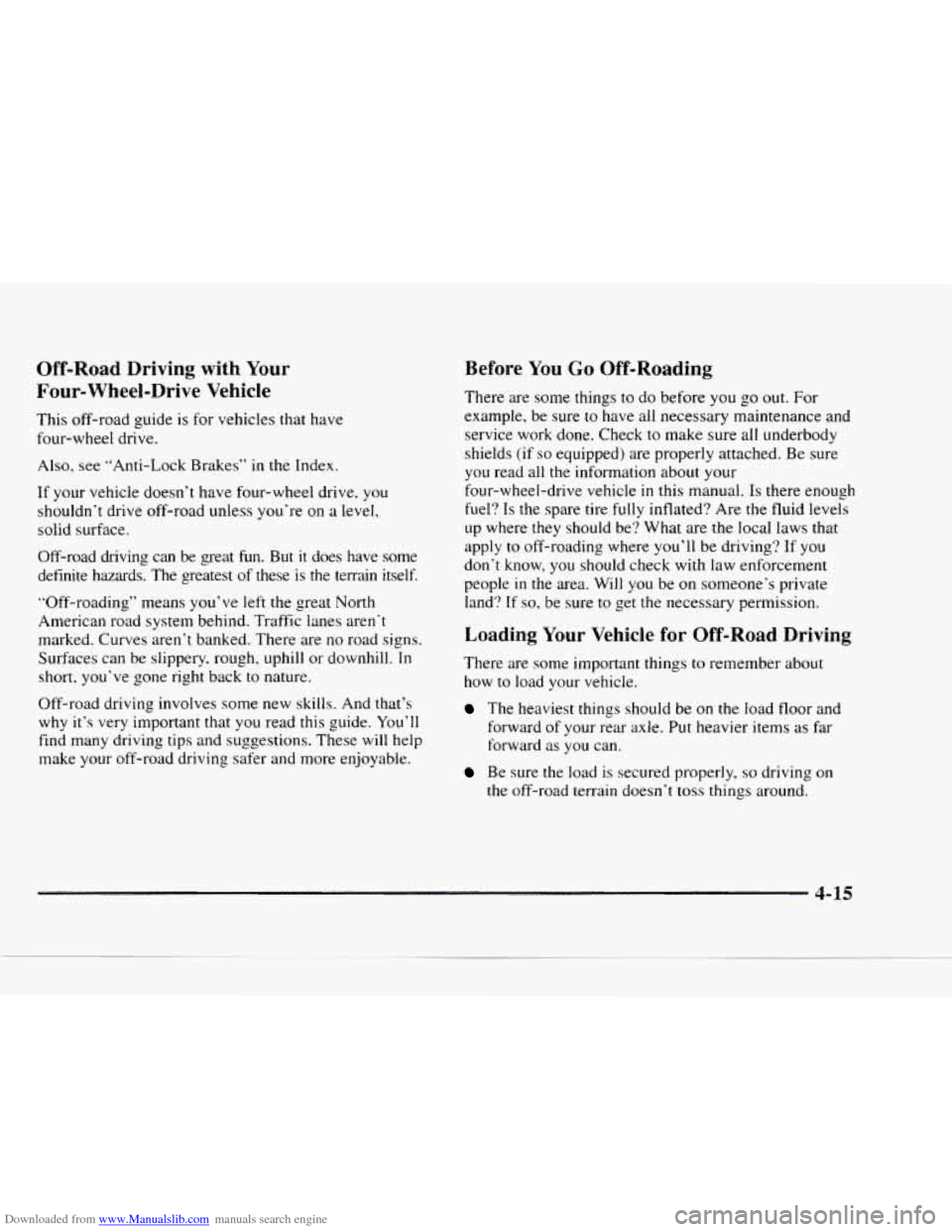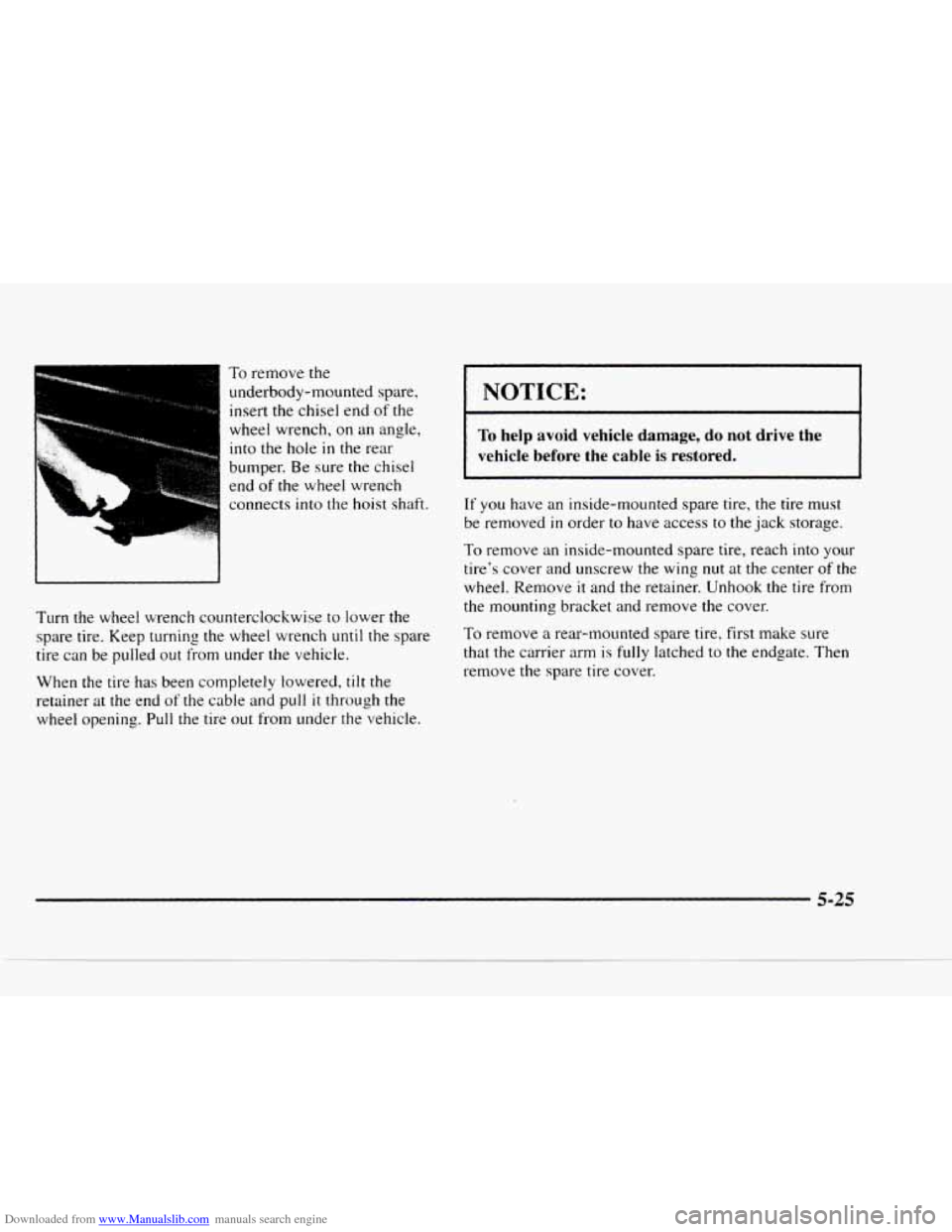Page 60 of 402
Downloaded from www.Manualslib.com manuals search engine This vehicle has one double-sided key for the
ignition, endgate, spare tire
lock (two-door vehicles)
and door locks.
It will fit
with either side up.
When a new vehicle is delivered, the dealer provides
the
owner with a pair of identical keys and a key
code number.
The key code number tells your dealer or a qualified
locksmith how
to make extra keys. Keep this number in
a safe place. If you lose your keys, you’ll be able to have
new ones rnude cusily using this number. Your selling
dealer should also have this number.
I NOTICE:
Your vehicle has a number of new features
that can help prevent theft. But you can have a
lot
of trouble getting into your vehicle if you ever
lock your keys inside. You may even have to
damage your vehicle to get in.
So be sure you
have extra keys.
Page 66 of 402

Downloaded from www.Manualslib.com manuals search engine EndgateLiftgate
A CAUTION:
It can be dangerous to drive with the rear
window, endgate or liftgate open because carbon
monoxide (CO) gas can come into your vehicle.
You can’t see or smell CO. It can cause
unconsciousness and even death.
If you must drive with the rear window, endgate
or liftgate open or
if electrical wiring or other
cable connections must pass through the seal
between the body and the rear window, endgate
or liftgate:
Make sure all windows are shut.
Turn the fan on your heating or cooling
system to
its highest speed with the setting on
VENT. That will force outside air into your
vehicle. See
“Comfort Controis” in the Index.
instrument panel, open them all the way.
If you have air outlets on or under the
See “Engine Exhaust”
in the Index.
Endgate Mounted Spare
If your vehicle has an endgate-mounted spare tire
carrier,
you must move the carrier arm out of the way to
open the glass.
Here’s how to move the arm:
d
I
1. Squeeze the release handle to free the carrier arm.
2. Swing the carrier arm away from the endgate. You
3. To latch the carrier arm, swing it toward the endgate.
may need
to give it a slight tug.
2-9
Page 176 of 402

Downloaded from www.Manualslib.com manuals search engine Off-Road Driving with Your
Four-Wheel-Drive Vehicle
This off-road guide is for vehicles that have
four-wheel drive.
Also, see “Anti-Lock Brakes”
in the Index.
If your vehicle doesn‘t have four-wheel drive, you
shouldn‘t drive off-road unless you‘re on a level,
solid surface.
Off-road driving can be great
fun. But it does have some
definite hazards. The greatest
of these is the terrain itself.
“Off-roading” means
you’ve left the great North
American road
system behind. Traffic lanes aren‘t
marked. Curves aren’t banked. There are
no road signs.
Surfaces can be slippery. rough, uphill
or downhill. In
short. you’ve gone right back to nature.
Off-road driving involves some new skills. And that’s
why it’s very important that you read this guide. You’ll
find many driving tips and suggestions. These will help
make your off-road driving safer and more enjoyable.
Before You Go Off-Roading
There are sutfre things to do before you go out. For
example, be sure
to have all necessary maintenance and
service work done. Check
to make sure all underbody
shields
(if so equipped) are properly attached. Be sure
you read all the information about your
four-wheel-drive vehicle
in this manual. Is there enough
fuel?
Is the spare tire fully inflated? Are the fluid levels
up where they should be? What are
the local laws that
apply to off-roading where you’ll be driving? If
you
don’t know, you should check with law enforcement
people
in the area. Will you be on someone’s private
land?
If so, be sure to get the necessary permission.
Loading Your Vehicle for Off-Road Driving
There are some important things to remember about
how
to load your vehicle.
The heaviest things should be on the load floor and
forward of your rear axle. Put heavier items as far
forward
as you can.
Be sure the load is secured properly, so driving on
the off-road terrain doesn’t toss things around.
4- 15
Page 218 of 402
Downloaded from www.Manualslib.com manuals search engine Section 5 Problems on the Road
Here you'll find what to do about some problems that can occur on the road.
5 -2
5-2
5-3
5 -7
5-12
Hazard Warning Flashers
Other Warning Devices
Jump Starting
Towing Your Vehicle
Engine Overheating
5-22
5 -22
5-23
5-35
5-36
Engine Fan Noise
If a Tire Goes Flat
Changing a Flat Tire
Compact Spare Tire
(If Equipped)
If You're Stuck: In Sand, Mud,
Ice or Snow
5-1
Page 241 of 402
Downloaded from www.Manualslib.com manuals search engine The following steps will tell you how to use the jack and
change a tire.
Removing the Spare Tire and Tools
The jacking equipment you'll need is stored along the
driver's rear wall.
In some cases. you may have to
remove the spare tire
in order to reach the jack. Your
vehicle is
also equipped with work gloves and a plastic
ground mat
to assist in the changing of a flat tire.
h
To remove your jack cover,
pull up on the latch at the
end
of the cover, near the
endgate and the latch
on the
top
of the cover. Remove
the wheel blocks, jack and
wheel wrench.
The following instructions explain
how to remove the
spare tire, depending on where it is mounted on
your vehicle.
[ NOTICE:
Never remove or restow a tire frodto a stowage
position under the vehicle while the vehicle
is
supported by a jack. Always tighten the tire fully
against the underside
of the vehicle when
restowing.
5-24
Page 242 of 402

Downloaded from www.Manualslib.com manuals search engine To remove the
underbody-mounted spare,
insert the chisel end of the
wheel wrench,
on an angle,
into the hole in the rear
bumper. Be sure the chisel
end
of the wheel wrench
connects
into the hoist shaft.
Turn the wheel wrench counterclockwise
to lower the
spare tire. Keep turning the wheel wrench
until the spare
tire can be pulled out from under the vehicle.
When the tire
has been completely lowered, tilt the
retainer at
the end of the cable and pull it through the
wheel opening. Pull the tire out from under the vehicle.
I NOTICE:
To help avoid vehicle damage, do not drive the
vehicle before the cable
is restored.
If you have an inside-mounted spare tire, the tire must
be removed
in order to have access to the jack storage.
To remove an inside-mounted spare tire, reach into your
tire's cover and unscrew
the wing nut at the center of the
wheel. Remove
it and the retainer. Unhook the tire from
the mounting bracket and remove the cover.
To remove
a rear-mounted spare tire, first make sure
that the carrier arm is
fully latched to the endgate. Then
remove the spare
tire cover.
Page 243 of 402
Downloaded from www.Manualslib.com manuals search engine I
The locking wheel nut can
be removed by snapping the
rubber weather cover
off the
face
of the lock case.
Insert the key
and pull
the lock case straight off.
It is not necessary to turn
the key.
Put the spare tire near the flat tire.
The tools you'll be using include the jack (A) and wheel
wrench
(B). Your vehicle may also have an optional hub
cap removal tool.
Page 245 of 402
Downloaded from www.Manualslib.com manuals search engine Removing the Flat Tire and Installing the Spare Tire 3. Fit the jack into the appropriate hole nearest the
tlat tire.
&
E
i
L
A. Front Frame Hole
B. Rear Frame Hole (2-Door) or Spring Hanger Hole
(4- Door)